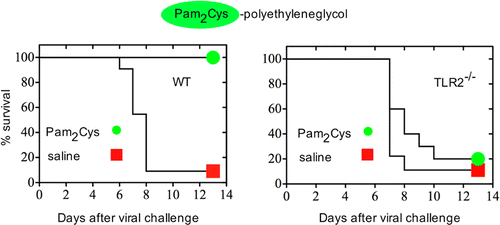An advance toward a flu-fighting nasal spray

In an advance toward development of a nasal spray that protects against infection with influenza and spread of the disease, scientists are reporting identification of a substance that activates the first-line defense system against infection inside the nose. They describe effects of a synthetic form of a natural substance found in bacterial cell walls in ACS' journal Molecular Pharmaceutics.
David C. Jackson and colleagues explain that the body's so-called innate immune system forms a first-line defense system against respiratory diseases like influenza A—which causes up to 1 billion infections and 500,000 deaths during seasonal epidemics. Those defenses swing into action almost immediately when viruses enter the nose and begin launching an infection. Scientists have been looking for ways to jump-start those defenses during flu outbreaks, and Jackson's team turned to Pam2Cys. That synthetic lipoprotein, a substance consisting of a fat and a protein, has shown promise in activating the innate immune system.
The team found in laboratory tests that using Pam2Cys as a nasal spray primes the body's immune system to fight infections. Importantly, they showed that the compound encourages but does not replace a normal immune response, which has been a concern about some anti-viral medicines. Because Pam2Cys stimulates the immune system against a wide spectrum of viral and bacterial attacks, the authors suggest it may be a particularly useful agent against pandemics and emerging viral strains.
More information: "Intranasal Administration of the TLR2 Agonist Pam2Cys Provides Rapid Protection against Influenza in Mice" Mol. Pharmaceutics, 2012, 9 (9), pp 2710–2718. DOI: 10.1021/mp300257x
Abstract
The protective role played by the innate immune system during early stages of infection suggests that compounds which stimulate innate responses could be used as antimicrobial or antiviral agents. In this study, we demonstrate that the Toll-like receptor-2 agonist Pam2Cys, when administered intranasally, triggers a cascade of inflammatory and innate immune signals, acting as an immunostimulant by attracting neutrophils and macrophages and inducing secretion of IL-2, IL-6, IL-10, IFN-γ, MCP-1 and TNF-α. These changes provide increased resistance against influenza A virus challenge and also reduce the potential for transmission of infection. Pam2Cys treatment also reduced weight loss and lethality associated with virulent influenza virus infection in a Toll-like receptor-2-dependent manner. Treatment did not affect the animals' ability to generate an adaptive immune response, measured by the induction of functional influenza A virus-specific CD8+ T cells following exposure to virus. Because this compound demonstrates efficacy against distinct strains of influenza, it could be a candidate for development as an agent against influenza and possibly other respiratory pathogens.















